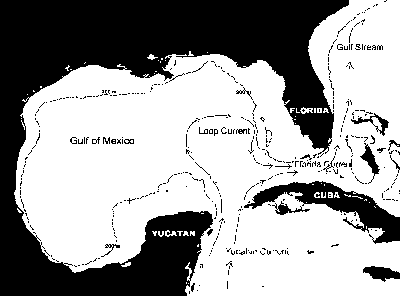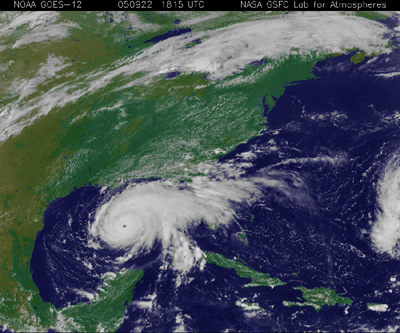
The circulation of currents through the Gulf of Mexico include the loop current. (Photo courtesy of NOAA)
GELLERMAN: You said “dire”?
WALKER: Gyre. Like a clockwise eddy, a huge eddy.
GELLERMAN: How big is it?
WALKER: Well it’s approximately 100 miles wide, and it’s a very deep warm pool of water. And it flows very rapidly; the waters in the Loop Current and the Gulf Stream are the fastest flowing waters in the Atlantic Ocean. They’re what we call part of the Western Boundary Current of the Atlantic Ocean.
GELLERMAN: Sounds very mysterious, actually. How deep is it and how warm?
WALKER: The Loop Current is about 800 meters deep. So that’s about 2,400 feet deep. And it’s very warm. It’s warmest at the surface, it’s approximately 85 degrees Fahrenheit at the surface at the moment; and temperatures above 80 degrees are conducive to intensification of hurricanes.
GELLERMAN: So, how does the warm water affect the intensity of a hurricane?
WALKER: The warm water is actually, it’s called the source of fuel for the hurricane because the winds evaporate the water, at the surface, obviously. And that water becomes the fuel for the hurricane when they condense as rain. And that is the energy source for the hurricane, primarily.
GELLERMAN: So, we could have seen this coming?
WALKER: Well, it’s more complicated than just, you know, the hurricane moving over the Loop Current. Because the Loop Current is in the Gulf of Mexico probably 95 percent of the time. It’s a normal feature of the Gulf of Mexico. You know, the fuel is there for hurricanes to intensify if they move over that current. However, Hurricane Ivan moved over the Loop Current and it did not intensify as Katrina and, recently, Rita did. So, there are other factors. And probably the key lies in the upper atmosphere, and it has to do with the temperatures and the humidity and the wind.
